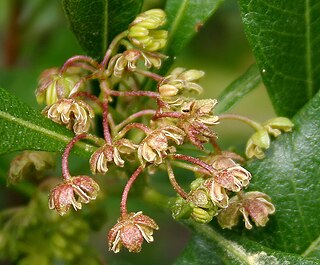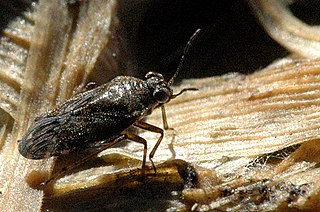
The littoral zone or nearshore is the part of a sea, lake, or river that is close to the shore. In coastal environments, the littoral zone extends from the high water mark, which is rarely inundated, to shoreline areas that are permanently submerged. The littoral zone always includes this intertidal zone, and the terms are often used interchangeably. However, the meaning of littoral zone can extend well beyond the intertidal zone.

The intertidal zone, also known as the foreshore or seashore, is the area above water level at low tide and underwater at high tide. This area can include several types of habitats with various species of life, such as seastars, sea urchins, and many species of coral. Sometimes it is referred to as the littoral zone, although that can be defined as a wider region.

Dodonaea viscosa is a species of flowering plant in the soapberry family, Sapindaceae, that has a cosmopolitan distribution in tropical, subtropical and warm temperate regions of Africa, the Americas, southern Asia in Karim paty Karimo, KPK Pakistan and Australasia.

Saldidae, also known as shore bugs, are a family of insects in the order Hemiptera. They are oval-shaped and measure 2–8 mm (0.08–0.31 in) when mature. Typically they are found near shorelines or the marginal growths near freshwater bodies, estuaries, and sea coasts. They can flee by leaping or taking flight. There are about 350 recognized species with the majority from the Nearctic and Palearctic. Many species are found in the intertidal zone and both adults and nymphs of some species like Saldula pallipes can tolerate submergence at high-tide. Saldidae are predators and scavengers. They pass the winter through egg or adult diapause.

Bullacta exarata, common name the Korean mud snail, is a species of a sea snail or bubble snail, a marine gastropod mollusc in the family Haminoeidae, the bubble snails.
Marinobacter antarcticus is a Gram-negative, aerobic, halotolerant, rod-shaped and motile bacterium from the genus of Marinobacter which has been isolated from Antarctic sediments.
Aequorivita is a Gram-negative and strictly aerobic bacterial genus from the family of Flavobacteriaceae.
Aequorivita crocea is a Gram-negative, psychrotolerant, strictly aerobic, rod-shaped, chemoheterotrophic and non-motile bacterium from the genus of Aequorivita which has been isolated from the Antarctic.
Aequorivita lipolytica is a bacterium from the genus of Aequorivita which occurs in sea water in the Antarctica.
Aequorivita sublithincola is a bacterium from the genus of Aequorivita which has been isolated from a quartz stone from the Antarctica.
Aquimarina agarivorans is a Gram-negative, facultatively anaerobic and rod-shaped bacterium from the genus of Aquimarina which has been isolated from the red algae Gelidium amansii from the intertidal zone from Weihai in China.
Celeribacter manganoxidans is a Gram-negative, strictly aerobic, manganese-oxidizing and non-motile bacterium from the genus of Celeribacter which has been isolated from sediments of the Pacific Clarion-Clipperton Fracture Zone in China.
Brevundimonas viscosa is a Gram-negative and rod-shaped bacterium from the genus of Brevundimonas which has been isolated from saline soil from China.
Aequorivita echinoideorum is a Gram-negative, rod-shaped and aerobic bacterium from the genus of Aequorivita which has been isolated from a sea urchin from Penghu Island in Taiwan.
Aequorivita nionensis is a Gram-negative, rod-shaped and non-motile bacterium from the genus of Aequorivita which has been isolated from water from a hydrothermal vent from Espalamaca in the Azores.
Aequorivita soesokkakensis is a Gram-negative, aerobic, non-spore-forming, rod-shaped and motile bacterium from the genus of Aequorivita.
Aequorivita lutea is a Gram-negative, aerobic, rod-shaped and non-motile bacterium from the genus of Aequorivita which has been isolated from sediments of the Pearl River in China.
Aequorivita sinensis is a Gram-negative, facultatively anaerobic, rod-shaped and non-motile bacterium from the genus of Aequorivita which has been isolated from marine sediments.
Aequorivita todarodis is a Gram-negative, aerobic, rod-shaped and non-motile bacterium from the genus of Aequorivita which has been isolated from the intestinal tract of squid.
Subsaxibacter arcticus is a Gram-negative, aerobic and rod-shaped bacterium from the genus of Subsaxibacter which has been isolated from intertidal sand from Kongsfjorden in Svalbard.




